|
Amazingly, Jiro Horikoshi himself, the actual designer of the famed
Mitsubishi 00 'Zeke' fighter, wrote this article in the November
1950 issue of Air Trails magazine in response to an article
that was published in the April 1949 issue titled, "The Great 'Zeke'
Mystery." A little on his background and a lot on the airplane's
background is presented in this extensive story. A lot of lessons-learned
improvements were integrated into the design. World War II
aircraft historians will surely be interested in this first-hand
account that was written very shortly after then end of the war.
I Designed the Zeke
By Jiro Horikoshi
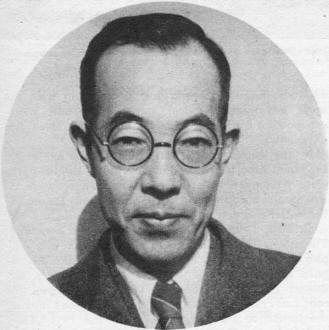
Here is the full, true account presented for the first time on
the origin and development of World War II's most controversial
aircraft. Designer Horikoshi who masterminded the Mitsubishi 00
lifts the veil on the Great Zeke Mystery
It might seem better if the man who designed the best-known fighter
plane of the losing side kept his peace. However, by the mysterious
channels through which back copies of publications travel, the April
1949 issue of Air Trails came into my possession. The American friend
who gave it to me pointed out David A. Anderton's article, "The
Great 'Zeke' Mystery," which indicated that the "Zero" fighter was
progressively "borrowed" from a number of other contemporary aircraft.
As the designer of the Zero, I would like to be permitted, for
the benefit of history, to set the record straight. The Zero fighter,
as the world got to know it. was no more copy than any other fighter
used in the world today. All single-engined all-metal low-wing monoplanes
are to some extent progressive "copies" of the original Junkers
"Bleichsesel," the father of all these machines. There is a certain
pool of common information from which all engineers. draw. There
is a certain reciprocal borrowing of detail ideas without permission
during wartime, and by cross-licensing in times 'of peace.
There have been few scientific studies of the Zero as an airplane
published anywhere. In Japan, it was naturally praised; overseas,
it was frequently subjected to certain ridicule, to dogma and to
prejudice. I am grateful to Mr. Anderton for his prompt discounting
of many of these false rumors and half-true reports. However, I
can best prove the originality of the design of the Zero by relating
its history and its background. Like people, airplanes have ancestors.
They get to look as they do partly by heredity and partly because
of the functions which they have to perform. This is, in essence,
the story of Zeke, as seen through the informed albeit maybe slightly
prejudiced eyes of its designer.

Taking off on a battle mission is a Zeke. This
is a Jap military photo from the personal files of author Horikoshi,
who was a top Mitsubishi designer.
Mr. Anderton, in his article, intimates that the world first
saw Zeke on that day all Japanese would like the world to forget,
Pearl Harbor Day. Had Mr. Anderton been given access to proper military
information which I am sure must have been at the disposal of leading
American military and naval intelligence personnel, he would have
known that the Zero had been in action on the mainland of China
for about a year and a half before the Pearl Harbor strike. In July
of 1940, it began to replace the leading Army type, the Type 96-4
carrier fighter which had been a standard machine since 1936. Since
the air phase of the operation in China was chiefly a Navy show,
the Mitsubishi 96-4 (A5M4) had, up to then, been the leading single-place
job.
Here let me explain, again for the record, how the .Japanese
numbering system of identification worked. The 96 denotes the year
that the plane was put into regular service, the 2596th year of
the old Japanese era, 1936 AD. The figure 4 indicates the fourth
modification or revision. The symbol A5 indicates that it is the
fifth fighter prototype built by Mitsubishi, or M. This system was
adopted by the Japanese in 1936, but was applied to planes built
before that period also in reference files. The Army and Navy, which
seldom got together on anything important, used somewhat different
designations for everything but the year of service.
As the war in China moved further inland, the Navy felt that
they needed a fighter with a much longer range, in order to escort
the bombers to and from the targets. It was this need for combination
of speed, range and maneuverability that begat the Zeke.
Mr. Anderton's knowledge of the early history of Japanese aviation
is remarkably sound. As he stated, Japanese Naval aviation is chiefly
British in its ancestry, while the Army aviation drew heavily from
French and German sources. These were the easy old days, after I
received my degree in aeronautics from the Imperial University in
Tokyo and entered the Nagoya Aircraft Works of Mitsubishi Heavy
Industries, Ltd., as a design calculator - or subordinate structures
engineer, as one would be called in the United States. This was
the period during which Japanese industry was trying to catch up
with the more advanced technical status of certain Western powers
by hiring experts and buying ideas and experience.
By the time I entered Mitsubishi, at the age of 23, the noted
American designer, Mr. Smith, and his party were no longer with
the company. There were no Americans with the firm at the time.
Prof. Baumann, the noted German designer, and Mr. Schade and Mr.
Keil, both from Junkers, were with the company. The noted French
designer, M. Vernisse, was employed in the outfit, as was Mr. Petty
from Blackburn Aircraft Co. in England, and his assistants, Mr.
Bolton and Mr. Wilkinson. These men stayed for contracts ranging
from one to three years during the formative period between 1926
and 1931. They designed aircraft, taught other engineers the techniques
of design. Unfortunately, I was in the lower echelon, my task was
supervising stress calculations, and I had no opportunity to contact
these foreign experts directly.
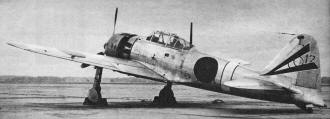
Captured Zeke was similar to one flown across
U. S. bearing Jap markings. Great consternation resulted when plane
spotters let it go by unnoticed.
This importation of foreign experts was universally practiced
during this period when Japan's infant aviation industry was gathering
momentum. Nakajima, Kawasaki, Aichi, Tachikawa - all of these had
experts from abroad on their payrolls. Their influence during this
period can be seen directly in the airplanes that were acquired
by the Army and Navy. During this period, the Japanese companies
went heavily into the purchase of patent licenses of all kinds.
For example, the Handley-Page-Lachman leading edge wing slot was
acquired jointly by Mitsubishi and Tachikawa for a hundred thousand
pounds. Licenses for accessories, engines, instruments and the like
were purchased wholesale, to permit the infant industry to get into
a competitive position.
I was sent abroad to study during this period, and from June
to December,1929, I traveled in Europe, England, France, Germany
and the Netherlands, visiting airplane factories. I stayed with
the Junkers company for three months, studying their procedure in
design. In December 1929 I embarked for the United States where
I visited many plants. I stayed several months at the Curtiss Company's
plant in Buffalo, where I acted as inspector for the P-6 pursuits
that had been purchased by Mitsubishi.
When I got home in the early fall of 1930, there was a new movement
in the air. The Japanese designers had a feeling that they wanted
to try their own ideas in designing. By 1932, the Japanese government
was about ready to listen. The Japanese Navy was particularly anxious
to start a new line of aircraft, built entirely by Japanese. They
ordered three important types under this program, a carrier-fighter,
a carrier torpedo-bomber and a reconnaissance seaplane. These were
designated as the 7-Shi Class since they were ordered during the
seventh year of the Showa reign or era, 1932. Nakajima and Mitsubishi
got orders for the carrier jobs, and I was appointed chief designer
of the carrier fighter, chiefly on the basis of my experience and
knowledge of fighters gained by contact with the P-6.
By this time, the trend was definitely to monoplanes in fighters.
By modern standards, the 7-Shi fighter was a clumsy, angular monoplane,
but it was in the contemporary line of design. The wings were thick,
full-cantilever structure, fabric covered, using the popular elliptical
planform that was the current leader. The fuselage was dural semi-monocoque
structure. The prototype had a three-strut landing gear. The second
machine had a full-trousered leg. The tail was dural structure,
fabric covered.
The machine was conventional for its time, many of its characteristics
having been dictated by the rigid demands for visibility and performance
laid down by the Navy.

Cloud of "Caudes" dung period when Japanese designers
stuck to the fixed landing gear; they felt the increased weight
for retracting gear wasn't worth tight speed gain.
None of the machines presented for the 7-Shi competition met
the Navy's requirements. Nakajima had presented a carrier version
of the old Army 91-type fighter, evolved by the French designer
Marie. I don't know what happened to the other machines in the 7-Shi
competition. Ours didn't fare too well. The original machine shed
a stabilizer during a power dive test. Luckily, the pilot bailed
out without any trouble. The second airplane went into a flat spin
during an aerobatic test, the ship went in from a double roll. The
pilot, Lt. Okamura, got out all right. Despite his bad experience
with my first original design, Lt. Okamura stood by me, giving me
ideas and encouragement for my further work.
By 1934, the Navy eased up on size and range demands for their
carrier fighters and dive bombers. By this time, I had a lot more
experience and a few more original ideas. When the call came for
the 9-Shi fighter, I conceived long, slim lines for the new ship
instead of the thick, stubby ones.
Most of the leading Navy pilots had most of their experience
on the old biplane fighters. They conceded the need for speed and
climb, but their tactical concept ideas still called for turning
combat, the old dogfighting idea. To get the combination of speed
and maneuverability into the airplane I desired, the answer was
a light airplane.
We retained the fixed landing gear in this design, since the
gear constituted only 10 percent of the overall drag. A retractable
gear would have raised the top speed from 400 to 410-15 km per hour.
We did not figure that the increased weight and mechanical complexity
of the retraction mechanism was worth the investment.
The 9-Shi incorporated the use of tension-field spar webs, an
idea that was brought to Japan from Rohrbach in Germany by Capt.
Wad a who later became Vice Admiral and Chief of the Navy's Air
Headquarters. This system permitted great lightening of the wing
structure, without sacrifice in strength.
The 8-Shi was the first plane in Japan to use flush riveting
and was probably the second design in the world to do so. The first,
I believe, was Heinkel He-70.
The first 9-Shi was test-flown at Kagamigahara Field in February
1935. It had a top speed. of 280 mph, faster than the old 7-Shi
and the Type 95 carrier fighter it was built to replace. The fabric-covered
Nakajima machines, built for the competition, were sold to the local
newspaper, "Asahi," to be used as liaison planes.
The first 9-Shi was an inverted gull-wing job, built without
flaps. The ship developed a pitching motion at high angles of attack,
due to the turbulent flow at the V-shaped concave part on the upper
surface of the wing. Thus, despite the better visibility and the
weight saving afforded by this configuration, the second 9-Shi had
a straight center section.
The 9-Shi was undoubtedly, as the Americans call it, a "hot ship."
A shallow approach was required, and the ship had a decided ballooning
tendency on touchdown. It was thoroughly tested under the supervision
of Lt. Comm. Yoshito Kobayashi, chief pilot of the flight test section.
Its virtues were noted, particularly its speed. Its faults were
analyzed, and corrective measures taken. Then the ship was used
for static testing.
The second 9-Shi was fitted with a split flap and a larger engine,
a direct-drive type, since the first machine had developed some
trouble with the reduction gear system. This machine suited the
rigid requirements of the Navy. On the basis of its performance,
the Navy tried to cancel an order for French Dewoitine D-510's.
They finally had to take two, which were kept, chiefly for the study
of the motor cannon. The noted pilot Marcel Doret flew the planes
on demonstration for us. We flew comparative tests against the 9-Shi
at Kasumigaura Navy Field, and the Mitsubishi machine proved superior
on almost every point of performance.
It is interesting to note that as early as 1927, Mr. Noda, then
chief of the wind tunnel section and later assistant manager of
Mitsubishi's Nagoya Works, filed patents on a simple split flap.
Because the prophet is often without honor in his own country, Mr.
Noda's flap was buried under the avalanche of foreign patents that
were being purchased. It was several years before the idea was picked
up and put to actual use.
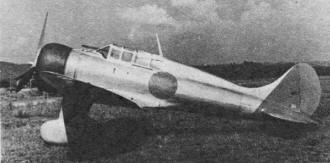
Type 96-2b Deck Fighter (A5M2b) known to us as
"Claude." The "96" indicates 2596th year of old Jap era (1936) when
plane went into service.
The gap between the final approval of the 9-Shi airframe and
its final adoption as a military machine stemmed from our inability
to produce a suitable powerplant. A number of radial engines, varying
from 600 to 800 hp were considered by the Navy. Finally, the smallest
unit, the Nakajima Kotobuki 2-1 was adopted because it was the most
reliable unit in production. The 9-Shi machine went into service
as the Type 96-1 Carrier F'iahter (A5M1).
For the time being, the production machine's performance was
lower than the prototype's, but it was put into production for use
in the Sino-Japanese conflict which began in July of 1937. There
were over a thousand of these fighters built; 800 by Mitsubishi
and two hundred odd by the Sasebo Naval Arsenal and the Kyushu Airplane
Company. Its power was progressively stepped up as better engines
became available. What went into actual mass production was a Type
96-4, powered with a 700 hp Kotobuki 41 engine.
During the time when the 96 was the leading Japanese fighter,
we had the opportunity of running comparative tests against the
Seversky P-35. We purchased ten of these for purposes of test and
study, and found that the machines were heavy, unmaneuverable and
did not compare with the performance of the Type 96 in virtually
all major points. Actual combat against the Gloster Gladiator, the
Curtiss Model P-75 and the Russian I-15 and I-16 indicated that
for most purposes, we had the superior machine. However, the Navy
was not deluded into believing that these tests made us the tops
in fighter design; it stood to reason that no country was going
to export its best aircraft. For that reason, we were encouraged
to improve our design and keep step with the world.
The Navy determined that the next machine, which was to be faster
and have reasonably proportionate performance, must retain greater
maneuverability than opposing aircraft. In brief, the Navy air strategists
wanted speed and climb, but they still demanded a tight turning
circle.
These were exacting demands; the sole solution appeared to be
in building the lightest possible airframe and keeping the wing-loading
as low as possible. We were forced, therefore, to eliminate consideration
of such things as fire protection, self-sealing tanks, armor plate
and anything else that was weight consuming. The design specifications
laid down by Naval Air Command appeared impossible.
We knew that Japan was a nation of limited resources. Therefore,
it was important that we build what airplanes we did produce as
superior machines. I had laid down three criteria for the design
of a fighter; performance, producibility and ease of service. For
a small country, performance was the major object - even at the
cost of the other two or if need be, the safety of the crews.
It was against this background of virtually impossible demands
that we began work on the 12-Shi prototype in 1937. We estimated
that it would take three years to produce the plane that Supreme
Command wanted. Yet as the war retreated further inland in China,
the range of the old 96 was proving inadequate. Even with drop tanks,
it was getting more difficult as the Chinese moved the scene of
battle further from the coast.
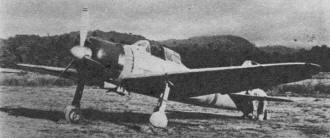
Type 00 deck fighter. The first plane to be termed
a Zero model was the 12-Shi land-based bomber designated "Betty"
by the American forces.
The earliest designs in the 12-Shi project were built around
the 875 hp 14-cylinder Mitsubishi Zue-sei engine, swinging a Sumitomo
two-position propeller, a Hamilton-Standard design. Later, the Nakajima
Sakae, a slightly larger and more powerful engine became available,
and was incorporated into the third machine. The bulk of the production
Zeros carried this engine. Later, when most of the Zeros were land
based, the Mitsubishi Kinsei engine was used.
To achieve the performance demanded by the Navy, weight conservation
was the prime order in the 12-Shi design. We built the wing in one
piece, thus eliminating heavy center-section fittings. We used the
smallest possible fittings to join the wing to the fuselage. The
flanges of the main wing spars were made of a pew type aluminum
alloy called ESD. The fuselage was built in two sections for convenience
in storing and for easier transport on trains. The entire structural
philosophy of the 12-Shi design was aimed at lightening the structure:
The plane itself was built for minimum air resistance, good control
and stability. The wing area was determined on the basis of keeping
the wing loading below 21.5 lbs, per square foot, in order to satisfy
the take-off, climb and turn requirements.
The 12-Shi model used a new wing curve that was specially created
for it. It has the same thickness ratio as the B-9, which had the
best polar curve at the time and a similar camber line as the NACA
23012 series with a maximum camber of two percent. The new airfoil
was designated as the Mitsubishi 118. Its polar curve was about
the same as the B-9, but it had only about half the movement of
the center of pressure. This same wing curve was used in the Type
1 land-based bomber, known in the U. S. as Betty.
To prevent tip stall the wing was given a 2 degree washout angle.
The tail surfaces of the Zeke were designed to give maximum longitudinal
and directional stability. The original planforms were laid out
to match that of the wing. This system used a removable tailcone,
which, we believed, would be useful for structural maintenance.
This system was used in the 7-Shi series fighters. A later experimental
model used a flat-sided fuselage, fairing into the rudder. Most
of the Zeke series used the tailcone configuration. The vertical
stabilizer and rudder on this first configuration was set above
the center line and well forward of the end of the fuselage. This
plane had fine spinning characteristics. Toward the end of the Zeke
run, the flat-sided fuselage was used for the sake of producibility,
and was also used on the later types that I designed, the Raiden
and Reppu.
The effect of our general effort toward aerodynamic refinement
showed up well in our competition with other fighters which emerged
later in the war. In comparative runs with the Army fighter "Hayabusa"
(Oscar) and "Shoki" (Tojo), our design showed itself to be a prime
design despite certain mechanical advantages enjoyed by the newer
ones. For example, the Oscar, with its more powerful engine was
equal in speed and climb and was a less maneuverable machine. Its
gross weight and useful load was the same.
In its general structural features, the Zero and the model 96
were quite similar. Aside from the obvious use of the retractable
landing gear and other improvements previously mentioned, the major
change was the extensive use of the ESD high-strength aluminum alloy
which was I developed by the Somitomo Co. This alloy is rich in
zinc and chrome, and was generally similar to other high-strength
alloys. Sumitomo pioneered this field and their product had 30-40
per cent greater tensile strength and 70-80 per cent higher yield
point than the alloys previously used.
This alloy, however, had definite limitations; it has a tendency
to develop cracks when rolled or extruded. Heavy extrusions had
to be clad heavily with pure aluminum, and proved reliable only
when these were furnished by the original supplier, and were usable
without bending or drawing. This limited the efficient use of the
alloy to relatively small aircraft and in such applications as main
spar flanges. I used the alloy only for this portion of the main
beams, but they did effect a considerable weight saving.
This philosophy of lightness in structure which characterized
the 12-Shi or Zero was basic in its nature; I we knew that we were
going to have certain problems at the outset, and we were willing
to take those chances in order to achieve the result we wanted.
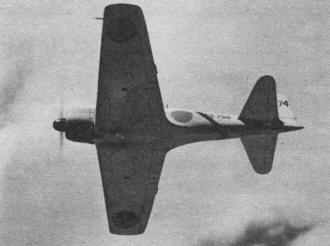
"Hamp" designation was given this Mitsubishi.
Americans had great difficulty understanding Jap method of numbering
planes all during war.
The first Zero was flown by Navy test pilots at Kagamigahara
Field in July, 1939, and was accepted by the Navy after 119 hours
had been put in on the prototype by the company's personnel and
43 by the Navy. The second machine was accepted in September 1939,
and the prototype was used for static testing. There was no great
pressure put on the Mitsubishi Company to produce the 12-Shi model
until early in 1940, since the old 96 was held adequate for use
in the Sino-Japanese operation. As a matter of fact, the first machine
to be termed a Zero model was our 12-Shi land-based bomber (designated
as Betty by the Americans). Performance tests were held with a number
of powerplants. There was a general beefing up of the airplane,
especially in the power section, and minor changes were made in
the control system to augment maneuverability.
During the trial period" we lost two experimental aircraft. Out
of these accidents, we learned that the ESD spars had certain structural
limits, and the wing structure, particularly the spar caps, were
redesigned. One of the victims was 1st Lt. Shimokawa, who was investigating
flutter during a. dive. Again there were structural revisions in
the wing.
The Zero went into service in China, as previously stated, in
mid-1940. However, there were progressive improvements in the design.
Actually, no Zeros were produced after August of 1945, the end of
the war, although my later designs, the Raiden and Reppu, were then
being readied for production.
The Zeke, as the war went on, was altered. Armament and power
were varied, armor and self-sealing tanks were added. On one modification
the wings were clipped to improve the rate-of-roll, general structural
concessions were made to permit better diving speeds. However, we
suffered to a great degree from an ultra-conservative topside, who
were slow to put into effective practice such changes.
In summing up the defense of the design originality of the Zero,
I will give credit where credit is due. As I stated previously,
and as virtually all competent airplane designers will hold with
me, the business of creating any new airplane is a process of adapting
the existing art and science to the problem at hand. For example,
I will state that the undercarriage retraction design on the Zero
was inspired by the Vought 143, and that the system for fastening
the engine cowl and the method of mounting the engine came from
other foreign planes. Any designer who fails, out of vanity, to
adapt the best techniques available to him, fails at his job, All
engineers are influenced by their teachers, by their experience
and by the constant stream of scientific information that is placed
at their disposal.
In the case of accessories, many of these were built under license
from abroad; wheels were manufactured by Okomato Engineering Company
under license from Bendix and Palmer, instruments were built by
the Tokyo Instrument Company under license, or later in the war,
by direct copy from Sperry, Pioneer and Kollsman. Sumitomo built
hydromatic propellers under a license from Hamilton Standard, as
well as the German VDM propeller. The Nihon Musical Instrument Co.
built the Junkers and Schwarz propellers, while the Kogusi Aircraft
Company built the French Ratier propeller. We built 20-mm cannon
licensed by Oerlikon of Switzerland and copies of the 13-mm (.50
cal.) Browning.
In the matter of communications radio, our material was adequate,
but not in the class of the U. S. equipment. Our radar never reached
full-scale use, although we had excellent research along these lines.
Our powerplant development was consistently behind the U. S. and
England. For example, we never developed a successful turbo-supercharger,
despite the obvious need for a high-altitude powerplant.
We did do a lot of early work in water-methanol injection, but
this was an attempt in the direction of improving power output with
91 octane fuel. It was no match for water with 100 octane.
Probably the major contribution of the Japanese during the war
to the field of aviation was the ESD prime material, and the production
technique developed for its proper use.
I can claim, in the study of the Zero, its ancestors and descendants,
that it was original to the same degree as other planes are, and
that while it contains certain special features that were all its
own, it serves as a prime example of a special design created to
suit an unusual set of circumstances.
Posted January 16, 2016
|